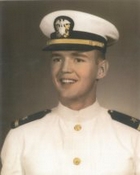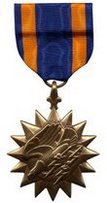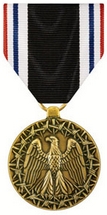This page is sponsored by Mark Haubenstein, founder of findmymedals.com, a website dedicated to helping veterans and their families research, recover or replace war medals. Mark is also a freelance writer and has written for "America in WWII" magazine. He resides in San Jose, CA.
Ron Dodge
| Date and Place of Birth: | June 17, 1936 Olympia, WA |
| Date and Place of Death: | circa 1967 (remains returned to U.S. on July 8, 1981) |
| Baseball Experience: | Minor League |
| Position: | Catcher |
| Rank: | Commander |
| Military Unit: | VF-51 U.S. Navy |
| Area Served: | Vietnam |
Ronald Wayne Dodge was born in Olympia, Washington, on June 17, 1936,
to parents Doris and Donald W. Dodge. A young sister Judy would follow a
few years later. His parents would eventually divorce, but Doris would
marry James B. King in 1946 and they would have two sons. Donald Dodge
served as a Chief Motor Machinist’s Mate in the U.S. Naval Reserve
during WW II, and he ran a successful dry cleaning business in Olympia
after the war. As his mother had, Ron attended Olympia High School where
he was a two-sport star athlete and a member of the Spanish Club. He
lettered in football his senior year, and as a junior in 1953, Ron was a
member of the Olympia High School State 4F Championship team, the only
football champions the school ever produced. Ron’s real talent, however,
was on the baseball field. He played varsity ball during his sophomore,
junior and senior seasons, lettering all three years. He was known to
hit for power from the left side, but was more noted for a cannon right
arm and for his superb defensive skills behind the plate. Ron’s close
friend in high school, was Gerry Alexander (Gerry had played center on
the football state championship team, and would later become a Chief
Justice for the state of Washington). He offered up a quaint nugget
about Ron many years later. During an interview in his chambers marking
his retirement from the bench, the reporter was John Dodge, Ron’s
cousin. “Here’s something you may not have known about your cousin,”
Alexander said. “He brought an egg salad sandwich for lunch every day in
high school.”[1]
After graduating high school in 1954, Ron attended the University of
Oregon. When school was over for the summer, he signed on with a semi-pro team
called the Washington “Cheney Studs” (later called the “Seattle Studs”).
The Studs were the brainchild of Ben Cheney, a local lumber executive
who had built several mills all along the West Coast and at one point,
owned a small stake in the San Francisco Giants. Cheney sponsored many
teams that were made up of local high school phenoms and young college
all-stars. Those teams competed with other semi-pro talent and played
exhibition games with professional Class B, or rookie league teams in
the Northwest League. Ron played well and eventually would catch the eye
of several professional scouts.
In 1959, at the age of 23, Ron joined the Missoula (Montana)
Timberjacks. He had grown to 6-foot-1 tall and was a sinewy 170 pounds.
The Timberjacks played in the Pioneer League, five rungs below major
league talent. The team was affiliated with the Washington Senators and
their home games were played at Campbell Park, whose most unusual
feature was a trapdoor behind home plate near the grandstand where the
players would emerge to enter the field. Ron appeared in only three
games with the “Jacks” and made just two plate appearances with no hits.
Continuing in 1959 and despite the lack of opportunity in Missoula,
Ron’s potential still outweighed his wonderful athletic ability. He
jumped to the Northwest League and the Yakima (Washington) Bears who
were part the Milwaukee Braves system. Led by manager Hub Kittle, the
Bears won the second half title and defeated the Salem (Oregon) Senators
in a playoff to capture the second of three consecutive league titles.
(Interestingly, the Bears only had a mediocre overall record of 70-69
for the season). Ron played in 36 games, had 89 at-bats, contributed 20
hits (including his only professional home run), and finished with a
.225 batting average. He also made two appearances as a pitcher, but did
not manage a linescore.
Ron finished out his 1959 season with the Seattle (Washington) Rainiers
of the storied AAA Pacific Coast League. The Rainiers were the top club
of the Cincinnati Reds at the time, and their roster featured many
soon-to-be and former major leaguers, most notably, Claude Osteen, Elmer
Valo, Hal Bevan, Dave Stenhouse, Jay Hook and Harry “Peanuts” Lowrey.
Ron’s time with the Rainiers would be the closest he would ever get to
“The Show”, being just one level below major league competition. In four
games, he made four plate appearances with just one hit. Ron ended his
one year, minor league career with 43 game appearances, 95 at-bats, 21
hits, five doubles, one home run, and an overall batting average of
.221.
In the mid-1960s, with his baseball career over and the Vietnam War
escalating, Ron chose to undergo the demanding and rigorous training as
a pilot in the U.S. Navy. With wife Jan and two small children, Ron and
his family relocated to San Diego, California in 1966. Home would be at
Miramar Naval Air Station, often noted as “Fightertown U.S.A.”. Ron was
assigned to VF-51, a fighter squadron attached to the aircraft carrier,
U.S.S. Hancock. The leadership skills he had honed on the baseball
diamond soon served Ron well as a young naval officer. He would be
chosen to fly lead on several missions, including his last, over the
flak filled skies of North Vietnam.
On May 17, 1967, Lt. Ronald Dodge was piloting his F8E Crusader jet high
above the jungle canopy of North Vietnam, about twenty miles northwest
of the city of Vinh. While on point, he encountered heavy anti-aircraft
fire and his plane was shot down. His wingman verified an opened
parachute near the crash site. Radio contact was made and at least three
radio transmissions were received with the last one being Ron claiming
he was “surrounded” and “heading up a hill” as he prepared to “break up
his radio”.[2] He waved his wingman off. Final visual verification noted
several NVA around the crash site, but no confirmation of Ron. The next
day, a local Vietnamese village newspaper and a Hanoi radio broadcast
verified a crash at the known site, and because of these facts, it was
assumed that Ron had been captured by the enemy.
In September 1967, a picture of a U.S. service member was published in
Paris Match magazine. The photo showed a beaten American with a bandaged
head being lead between two armed guards. Several government sources (as
well as Ron’s wife), identified the airman as Lt. Ron Dodge. Later, an
East German propaganda film titled “Pilot in Pajamas” featured clips of
purported to be POW’s, including Ron, this time without a bandaged head
and walking under his own power. When this evidence was presented to the
North Vietnamese, the U.S. demanded to know Ron’s status and his
whereabouts. The North Vietnamese denied any knowledge of him, and in
fact, feigned astonishment that they would be accused of withholding any
information of the sorts.
On November 10, 1972, Ron unknowingly became the face of the POW-MIA
movement in the U.S. The Paris Match photograph appeared on the cover of
Life magazine, slightly cropped, with the heading, “QUESTIONS FOR A
PEACE”, along with “543 POWs: What shape are they in?”; “1271 MIAs: How
many are still alive?”; “Where Does It Leave us?” and “An Ohio Town
Talks of War”.[3] The ensuing public outcry fueled much more debate at
the Paris peace talks, with both sides making demands and accusations
and with the North Vietnamese issuing their same tired denials. As the
war was winding down, the American people demanded answers and simply
wanted their boys home. ALL of their boys.
In early 1973, the U.S. exhaustively negotiated the release of all POWs
held captive by the North Vietnamese. Beginning in February, U.S. POWs
finally boarded C-141 military aircraft with teary eyes, bright smiles
and raised fists. Some had been held captive for over 8 ½ years. In all,
“Operation Homecoming” returned 591 POWs to American soil. Sadly, Ron
was not among them. After debriefing of fellow prisoners, there was very
little information they could share about Ron. Many speculated that Ron
had been beaten and tortured, and had died at the hands of his captors
shortly after his plane crash. For those waiting, this was a cruel,
devastating blow.
In July 1981, the North Vietnamese “discovered” the remains of three
American pilots and turned over their remains and other “personal
affects” to the U.S. government on July 8. The pilots were identified as
Air Force Capt. Richard Van Dyke, Navy Lt. Stephen Musselman and Navy
Cmdr. Ronald Dodge (Ron had been promoted in captivity). After fourteen
emotionally long and gut wrenching years, Ron would now come home. “I
guess it’s all over, all the waiting” said Brad Dodge, Ron’s 17-year-old son who was just three years old when his father went missing.
“My mother was pretty upset. We’ve been waiting all these years to find
out. I guess it’s better, though”.[4]
Ron is remembered as a tremendous baseball athlete and a true American
hero. For service to his country, Ron earned the Purple Heart, the POW
Medal, the Air Medal, the National Defense Medal, and the Vietnam
Service and Vietnam Campaign Medals. He is interred at Arlington
National Cemetery, Section 23, Site 22520. Ron is also honored on the
Vietnam Memorial in Washington, DC, Panel 20E, Line 14.
© Mark Haubenstein, February, 2012 (permission of use granted).
Notes
[1] The Olympian, Olympia Washington, Dec 17, 2011
[2] The pownetwork.org (crash site report)
[3] Life magazine, Nov 10, 1972
[4] AP newswire, Tacoma News Tribune, Tacoma Washington, July 22, 1981
Tacoma Public Library Online Archives
The 1954 Olympiad, Olympia High School Yearbook
The 1967 U.S.S. Hancock WestPac Cruise Book
Togetherweserved.com
FindAGrave.com
Baseball-reference.com
Date Added February 11, 2012 Date Updated March 17, 2014
Baseball's Greatest Sacrifice is associated with Baseball Almanac
Baseball's Greatest Sacrifice is proud to be sponsored by





